火星 月惑星研究会 関西支部 (最新)
ALPO-Japan Latest
Mars Image 2001/07/01
永長英夫,風本明,西谷輝昭,新川勝仁,Tan Wei Leong,米山誠一,
池村俊彦,荒川 毅,森田光治,畑中明利,中西英和,安達 誠,奥田耕司,Ed Grafton
H.Einaga,A.Kazemoto,T.Nishitani,M.Niikawa,T.W.Leong,S.Yoneyama
T.Ikemura,T.Arakawa,M.Morita,A.Hatanaka,H.Nakanishi,M.Adachi,K.Okuda,E.Grafton
Tim Parker's images
解説(安達)
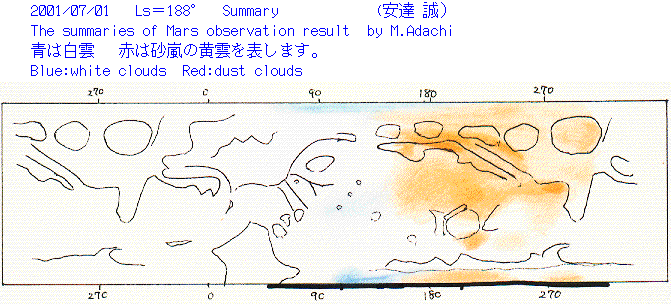
Used our web and International Mars Watch.
黄雲はさらに広がり、北半球にも次第に波及してきました。かろうじてカロンの三差路(Trivium Charontis;200°、+20°)付近と、アエテリアの暗斑(Aetheria;240°、+40°)付近が暗く見えています。しかしながら、画像を詳しく調べてみますと、周囲をダストストームに広く覆われています。この部分は北半球で最も高くなっている部分であることから、ダストストームがはい上がれずにいるものと思われます。ちょうど、エリシウム(Erysium;215°、+20°)のすぐ北側に明るい黄雲が発生しており、光斑となって画像に写りました。
南半球の黄雲は濃密な部分がキンメリウム(Mare Cimmmeriumu;220°、
-20°)からシレーン(Mare Sirenum;160°、-30°)にかけてひろがって行った様子が認められます。また、南極地方もほとんど黄雲に覆われ、極冠を見ることができなくなりました。
北極地方のダストストームはさらに大きく広がってきました。
Explanations M.Adachi
The dust storm became even stronger in 28 June. And, it spreaded to northern hemisphere. The Trivium Charontis and dark spot of Aetheria were dark seen. These were encircled by dust storms. This region was higher than all of the northern hemisphere. Consequently, dust storm never enter this region.
Bright spot of the dust storm was appeared on the northern Elysium.
Stronger dust storm was covered by Mare Cimmerium-Mare Sirenum region. SPR was covered by the dust storm.
|
|
Hideo Einaga (250mm Newton, Digital Still Camera NEC PICONA)
|
|

2001/07/01 12:16:22 (UT)
Ls = 187.81, CM = 200.15
De = +6.13, Dia = 20.48"
8 frames composite
Seeing=3/10,Trans=2/5, F=37
25cm+LV12mm+prism 6d+Picona(1/7s)

2001/07/01 13:40:41 (UT)
Ls = 187.84, CM = 220.71
De = +6.14, Dia = 20.47"
12 frames composite
Seeing=4/10,Trans=3/5, F=37
25cm+LV12mm+prism 6d+Picona(1/7s)
HIDEO EINAGA ≪兵庫・加西 永長英夫≫
|
Akira Kazemoto(203mm Newton, Digital still camera NEC PICONA)
|
|
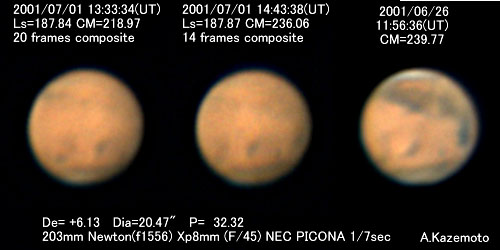
シーイング 5/10
南半球はダストストーム(?)のため
殆どが隠されてしまいました。ビックリですね。
26日の画像と比較してください。
≪京都府久世郡 風本明≫
|
Teruaki Nishitani (210mm Newton, Digital still camera NEC PICONA)
|
|
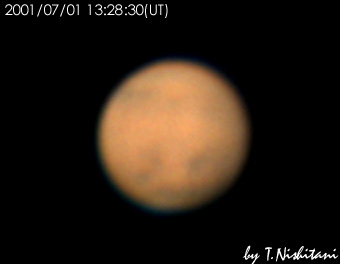
2001/07/01 13:28:30(UT)
Ls=187.84 CM=217.74
De= +6.13 Dia=20.47"
P=32.3200826
by T.Nishitani
21cm F6 Newton(ASKO) Power Mate 5X
NEC Picona 1/7sec. 30 frames composite
≪滋賀県甲賀郡 西谷輝昭≫
|
Masahito Niikawa (280mm SC, Digital still camera Minolta DimageEx1500)
|
|

Mars on Jul.01, 2001
Ls = 187.9, De = +6.1, Dia = 20.5"
[R1]
2001/07/01 14:22:15 (UT)
CM = 230.8
19 frames composite
[R2]
2001/07/01 16:33:24 (UT)
CM = 262.8
7 frames composite
Observer:Masahito Niikawa
Email:zba03198@bird.zero.ad.jp
Obs.site : Mozuhonmachi Sakai-City Osaka Japan
Telescope : C11 (SC) D=280mm fl=2800mm
Camera:Minolta DimageEx1500 Digital Camera taking lens removed
CCD:ICX205AL (Sony Monochrome CCD)
Filter: R64 (640nm - 1000nm)
Exposure :1/15, 1/8 sec
Effective F No.: 36 (XP24mm Eyepiece Projection)
Seeing = 5/10 -> 1/10
Transparency = 2/6 -> 1/6
Image Processing:
Enhanced with unsharp masking method.
Caption:
Mare Cimmerium and Mare Tyrrhenum, the prominent dark pattern of
the Southern hemisphere of Mars, has been coverd with the global
dust storm.
Near the center of the image [R1] (Aethiopis) BrightsSpot noted dark
However Azania, Hyblaeus, Nodus Alcyonus, and Syrtis Major are noted
The dust storm seems not to expand to the northern hemisphere yet.
The image [R2] is blurred ouing to bad seeing.
説明:
Mare Cimmerium, Mare Tyrrhenumという火星の南半球の顕著な模様が、
大規模なダストストームに覆われてしまった。
画像[R1]の真ん中付近 (Aethiopis) に明るいスポットがある。
しかし、Azania, Hyblaeus, Nodus Alcyonus, Syrtis Majorは暗い
ダストストームは、まだ南半球まで拡がっていないようだ。
悪シーイングのため、画像[R2]はぼけている。
大変なダストストームになりました。
雲間をぬっての観測なので、赤しか撮れませんでした。
深夜まで粘って、シルチスが見えることは
確認できました。
≪大阪府 堺市 新川勝仁≫
|
Tan Wei Leong(celestron C11 SC,ST7E Cold CCD CAMERA)
|
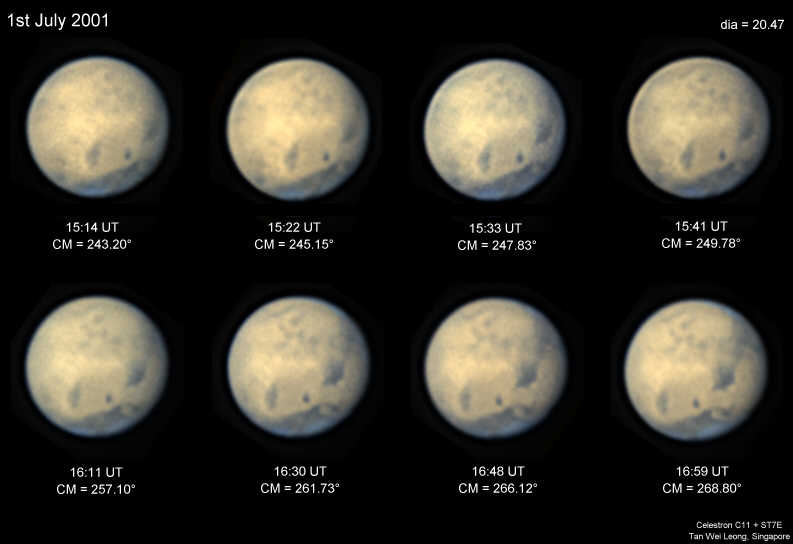
Attached is the image from last night. I acquired a set of 8 images earlier and will be processing them later today. Meanwhile for this shot I experimented with eyepiece projection and this image was shot at f/33 for a sampling of 0.20"/pixel. Seeing was about 3-5/10. The poor seeing makes focusing very difficult.
It seems like the region from part of Iapygia southward to M. Hadriaticum and eastward to M. Tyrrhenum and M. Cimmerium has been covered by the massive dust storm.
There appears to be 3 large bright areas on my image, one is at Hellas, the other region just south of Elysium and the last one eastward to Hesperia area.
Please take a look and correct me if I'm wrong. I'm trying hard to learn :)
Regards and Clear Skies
E-Mail [Tan Wei Leong Singapore] weileong@singnet.com.sg
--------------------------
アイピース拡大の方法でF33にし、1ピクセルあたり0.2"
で撮影してみました。
シーイングが良くない Seeing 3-5/10.
私のイメージでは3個所に大きく明るいエリアがあるようだ。
Hellas 、ちょうど Hesperia エリアに東のエリシウム、
及び、もうひとつ南半球の領域にある。
なにかまちがっていたら教えてください。
Attached is the mars sequence done on 1st July 2001, this is done with the
C11 at f/23. Just finished processing it. The skies is cloudy now and I
finally ha the chance to catch a good night's sleep after staying up to
image/process mars.
I think I like this color balance more because it very similar to what I see
through the C11 instead of orange. Strange enough if I balance the RGB ratio
according to the filter characterist and exposure times I get a orange. Most
of the images I see seems to give an orange mars. Can someone please advise
me regarding this?
Japanese
暇を見つけてやっと7月1日の画像を全部処理した。
私はこのカラーバランスが気に入っている。
C11でオレンジフィルターで見たときと良く似ている。
眼視でも、オレンジ色終始している。
何かアドバイスをください。
|
Seiichi Yoneyama(200mm F4 Newton, Digital still camera NEC PICONA)
|
|
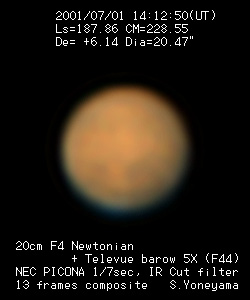
eeing:2/5 Transp.:4/5
シーイングが悪い為か、眼視でもピコナのモニターでも火星面の模様がほとんど見れませんでした。月面でピントを合わせたので、ピンぼけでは無いとおもいます。
もしかすると、例の雲か砂嵐が、火星面の広範囲に広がって模様が淡くなっている可能性があると感じたので、画像を送ります。
≪神奈川県横浜市 米山誠一≫
|
Toshihiko Ikemura (310mm Newton, Digital still camera NEC PICONA)
|
|
 650コマも撮影してしまい、選択がたいへんでした。
650コマも撮影してしまい、選択がたいへんでした。
30コマもコンポジットしてかなり強く強調しても模様がかすかにしかでません。
≪愛知県名古屋市 池村俊彦≫
|
Tsuyoshi Arakawa (300mm Newton, Digital still camera NEC PICONA)
|
|
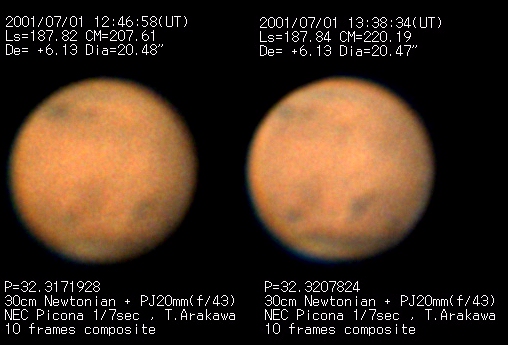
12:46 の方は、シーイング 7/10
13:38 の方は、シーイング 8/10 でした。
やはり、これだけ安定すると送風機は使わない方が、結果は良いようです。
≪奈良県奈良市 荒川 毅≫
|
Mitsuji Morita(200mm Newton, Digital still camera NEC PICONA)
|
|
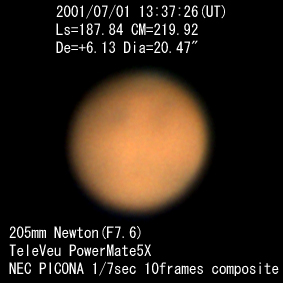
久しぶりの観測であったが、シーイングは最悪。激しく揺れる大気を通してみる火星は、ただ黄色い円盤として見えるだけで、模様はかろうじて認められる程度。詳細は不明。
≪滋賀県守山市 森田光治≫
|
Akitoshi Hatanaka (400mm Cassegrain, Video Camera Sony TRV9)
|
|
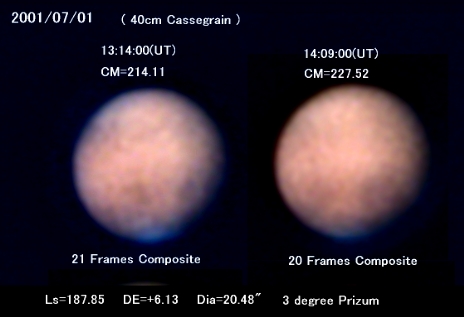
2001/07/01
1. 13:14:00(UT)
Ls=187.84 Dia=20.48”
CM=214.11 DE=+6.13
21Frames Composite
2. 14:09:00(UT)
Ls=187.86 Dia=20.48"
CM=227.52 DE=+6.13
20 Frames Composite
40cm Cassegrain(F15)
Or25mm Sony TRV-9
3 degree Prizum
南半球の模様が淡い、
雲がかなり広範囲に広がっているのか。
北極冠らしいものが見えてきた。
≪三重県熊野市 畑中明利≫
|
中西英和 Hidekazu Nakanishi (Meade 250mm SCT, Starlight Xpress MX916 Cooled CCD Camara)
|
|
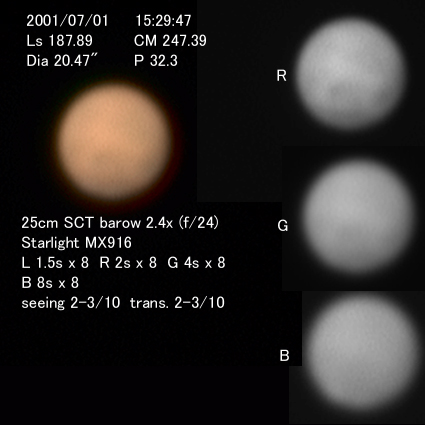
風があって、大変条件の悪い夜でしたが、変化が気になり撮影しました。
やはり、雲はさらに広がっているようで南半球全体がかすんでいます。
≪愛知県尾西市 中西英和≫
|
Makoto Adachi (Drawing: 310mm Newtonian)
|
|

2001/07/01 12h10m(UT) 2001/07/01 13h30m(UT)
CM=198.6 DE=+6.1 CM=218.1 DE=+6.1
Ls=187.8 Dia.=20.5 Ls=187.8 Dia.=20.5
Seeing;2/10 Transp.=3/5 Seeing;2/10 Transp.;3/5
シーイングは悪いが、重要なときだけに慎重に観測した。暗色模様ではなく、明るい雲の観測に中心をおいて観測しようとしたが、気流が悪く、思うような成果はでなかった。キンメリウムよりも南側はやや明るくなっており、この部分には広範囲にわたってダストに覆われている様子が観測されたに過ぎなかった。南極冠があるのかないのか、それすら判断が難しかった。
プロポンティスやアエテリアの斑点が見られるところを見ると、北半球にはまだはっきりとしたダストは出ていないようだ。
The dark spot of Propontis 1 and the dark spot of Aetheria was dark and visible. So that, I think that Northern hemysphere is not covered by the dust storm.
≪滋賀県 大津市 安達 誠≫
|
Koji Okuda (250mm Newton, BITRAN BT-01 Cooled CCD Camera)
|
|

:キンメリヤ人の海がかなり淡くなった
:黄雲が東側にかなり広がったようだ
≪滋賀県信楽町 奥田耕司≫
|
Ed Grafton, Houston Texas ( ST6 CCD 14 inch f/11 Celestron SCT)
|
|
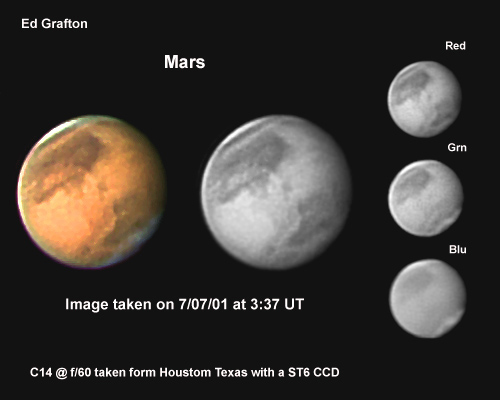
[Ed Grafton, Houston Texas]
 ALPO-Japan Latest
ALPO-Japan Latest  Mars2001 Apparition
Mars2001 Apparition











 650コマも撮影してしまい、選択がたいへんでした。
650コマも撮影してしまい、選択がたいへんでした。






 ALPO-Japan Latest
ALPO-Japan Latest